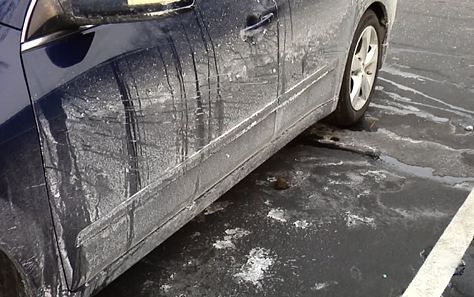
When it comes to winter, we tend to obsess about snow, ice and cold. But what about all the road salt and sand that come with these often nasty elements? Yes, we appreciate that they serve in the interest of public safety—the rock salt helps melt ice even if it’s freezing, and the sand keeps salt in place. But they can really inflict some major punishment upon a vehicle, destroying its finish, increasing rust and even hurting driving performance. Doors, fenders, hoods and tailgates are most vulnerable to rust because they retain a lot of moisture.
Why does a car rust from road salt?
Metal parts of a car come in contact with precipitation water containing carbon dioxide and oxygen. Road salt contains free-radical ions and they come into contact with the precipitation water. After extended exposure to oxygen, iron oxide forms, which speeds up the rusting process.
How does road salt work?
Road salt was first introduced in the 1930s as a combatant to make roadways safer for driving. It does this by a chemical reaction lowering water’s freezing point, melting ice so tires can make contact and get traction with the pavement.
It helps prevent the vehicle from sliding when ice is present on the road. The down side to this very important part of road safety, is it’s highly corrosive to vehicles and over time causing rust. The damage can be extensive, but being that it is an abundant, cost effective and easy to work with source, it is arguably the best choice.
Rust is one of the biggest threats road salt residue can cause for vehicles, with repeated exposure, due diligence by the owner is needed. Road salt affects the car’s paint causing corrosion, rust begins forming underneath bubbling up and the metal becomes brittle and flakey. Eventually the damaged area breaks free and if left untreated a hole can occur.
Since road salt promotes rust and can affect its mechanics, the undercarriage of a car or truck has multiple areas road salt can damage if left unmaintained. From the frame to the hydraulic brake system, rust can do serious damage making the car unsafe to drive.
For example, the hydraulic brake system carries brake fluid to the brakes for them to expand. If salt causes damage to the line resulting in a leak, the brakes don’t work properly, or in some cases not at all.
The Fight Against Road Salt Car Damage – What can you do?
- Wash your car as soon as possible after each snow or ice storm.
- Wash your car when temperatures reach 40 degrees Fahrenheit or higher.
- Washing your car in daylight hours gives it a better chance of completely drying before temperatures drop at night time.
- Open and close all the doors, hatch and trunk after washing your car, and lock and unlock doors multiple times. This should be done as soon as possible to prevent freezing shut.
- Avoid driving in deep snow; it packs against the bottom of the car. This can contribute to rusting and cause driving hazards.
The Finish on a Car – How can you protect it?
Tip: Rain and snow collect the pollutants in air covering your car. This can damage a car’s protective clear-coat finish.
- Wash your car as soon as possible after each rain shower or snow storm.
- Using a car wash that does not use recycled water, wash the undercarriage frequently.
- Road salt collects in pools of water. Avoid driving in puddles.
- If a paint chip is larger than the tip of a pen, repair it as soon as possible to avoid rust corrosion.
- To protect your car, apply wax to your car at least every 6-months.
- Use a car cover for snow
Road salt is a part of life for those who live in wintery weather areas. Follow these effective tips to provide safe driving condition.